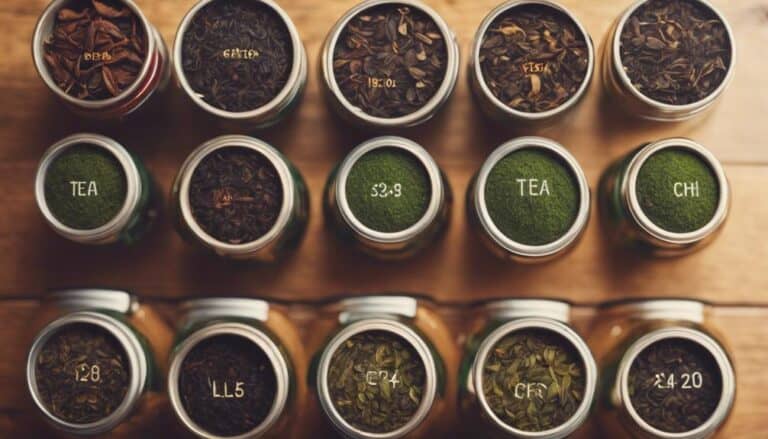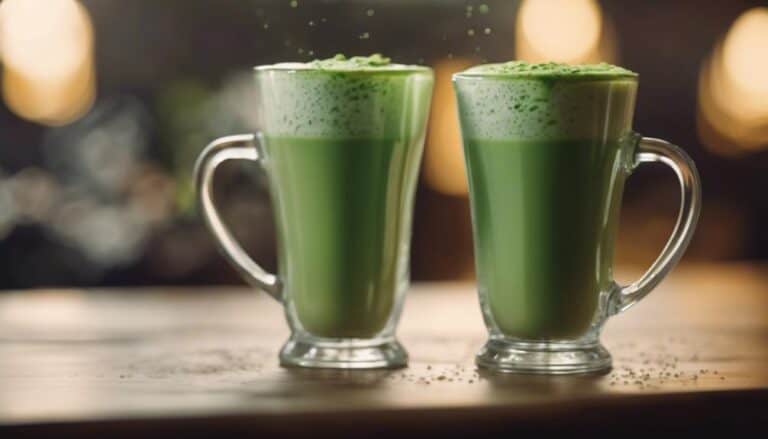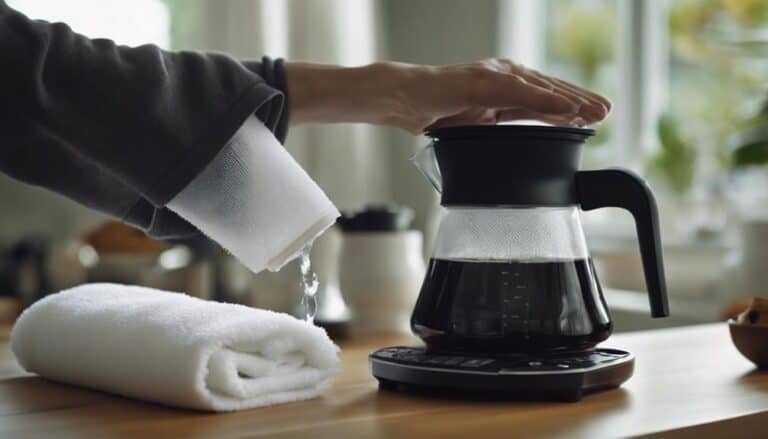Boba Balls Ingredients

When it comes to boba balls, understanding the precise combination of ingredients that go into creating these delightful chewy pearls is essential. The interplay between tapioca starch, dark brown sugar, water, and food coloring is what gives boba balls their distinct flavor and texture. But what about the process of crafting these ingredients into those beloved little spheres? Stay tuned as we unravel the secrets behind the art of shaping and perfecting the ideal boba ball, promising a satisfying chewiness that keeps us coming back for more.
Key Ingredients for Boba Balls
When making boba balls, tapioca starch serves as the primary ingredient essential for achieving the desired chewy texture. This starch is derived from the cassava root and is what gives boba pearls their distinctive consistency.
To make the boba dough, tapioca starch is combined with water to form a pliable mixture that can be shaped into small balls. Additionally, brown sugar is a key ingredient used to sweeten the boba balls, adding a rich flavor to complement the chewy texture.
If one desires the classic black color of boba balls, food coloring can be incorporated into the dough mixture. The combination of tapioca starch, water, brown sugar, and food coloring is what ultimately creates the iconic boba balls that are enjoyed in bubble tea worldwide.
Mastering the proportions and technique of incorporating these ingredients is essential in achieving the perfect boba balls.
Tapioca Starch
Tapioca starch, extracted from the cassava root, is a gluten-free starch known for creating a sticky and chewy consistency ideal for boba pearls. This versatile ingredient is a staple in Asian cooking, offering a unique texture to various dishes.
With its high carbohydrate content, tapioca starch provides a substantial base for boba pearls, contributing to their satisfying chewiness. The presence of resistant starch in tapioca starch further enhances the soft and elastic nature of boba pearls, making them a popular choice in bubble tea drinks. Its ability to absorb and retain moisture gives boba pearls their characteristic texture, ensuring they remain chewy even when submerged in liquids.
When combined with other ingredients in the boba balls recipe, tapioca starch plays a vital role in forming the desired consistency and mouthfeel, making it an essential component for creating this beloved treat.
Dark Brown Sugar
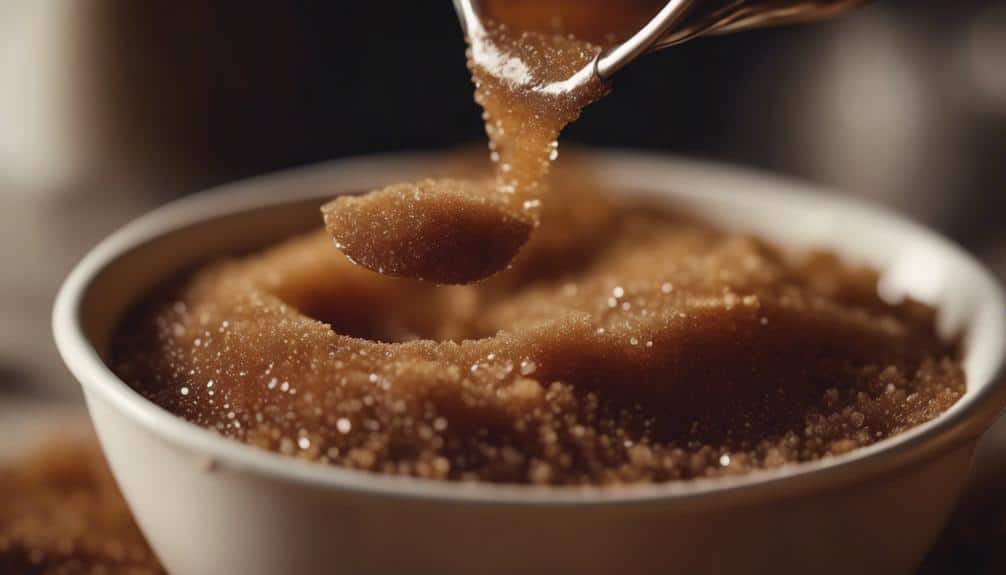
Utilizing dark brown sugar in the boba balls recipe enhances the flavor profile and visual appeal of the chewy pearls.
- Rich Flavor and Color: Dark brown sugar is commonly used in making boba balls for its rich flavor and color, adding a caramel-like sweetness to the boba pearls.
- Complex Flavor Profile: The molasses content in dark brown sugar gives the boba balls a deeper, more complex flavor profile, balancing the sweetness in the recipe.
- Visual Appeal: Dark brown sugar helps create a glossy sheen on the boba pearls, making them visually appealing alongside other ingredients.
- Complementing Ingredients: When added to boba balls, dark brown sugar complements the tapioca pearls, flour, and tea, creating a harmonious blend of flavors in the syrup.
Water
Water plays an essential role in the boba balls recipe, providing necessary hydration for the dough. The pivotal amount of water is important as it affects the texture and consistency of the boba balls. Using hot water is significant as it aids in the gelatinization process of tapioca starch, resulting in a smooth and pliable dough. The water temperature is a key factor in activating the tapioca starch and ensuring proper dough formation. Water acts as a binding agent, helping to bind the tapioca starch and sugar together to create the base for shaping the boba balls.
| Water in Boba Balls | |
|---|---|
| Importance | Hydrates the dough |
| Temperature | Hot water aids in gelatinization |
| Function | Binds ingredients for proper dough formation |
| Effect | Influences dough consistency |
| Role | Essential for creating smooth dough |
Food Coloring

To achieve the desired black color of boba balls, food coloring is essential in the preparation process. When working with food coloring for boba balls, certain considerations should be kept in mind:
- Commonly, black food coloring is used to achieve the classic look of boba pearls.
- The amount of food coloring used can be adjusted based on brand or personal preference.
- Food coloring should be mixed into the dough during the boba pearls making process.
- Using glass or metal bowls when working with food coloring helps maintain the integrity of the coloring.
Maintaining the integrity of the black color in the dough is vital to ensure the final product's appearance. Adjusting the amount of food coloring used allows for customization according to personal taste or specific brand preferences. Mixing the food coloring into the dough evenly and thoroughly, in either a glass or metal bowl, is essential for consistent coloring throughout the boba balls.
Crafting the Dough
When crafting the dough for boba balls, it's essential to mix the ingredients, ensuring a homogeneous blend of tapioca starch, water, and sugar.
The next step involves rolling the dough until it reaches a smooth and pliable consistency, ready for shaping into uniform balls.
Incorporating cocoa or matcha powder can provide options for coloring the dough, adding a creative touch to the boba balls.
Mixing the Ingredients
Crafting the dough for boba balls involves combining tapioca starch, hot water, and dark brown sugar to achieve a smooth and pliable texture essential for shaping uniform boba pearls.
- Mixing Ingredients:
- Combine tapioca starch, hot water, and dark brown sugar.
- Stir until the mixture is well incorporated.
- Confirm the tapioca starch is fully hydrated.
- Aim for a smooth and elastic dough consistency suitable for shaping boba pearls.
Rolling the Dough
After combining the tapioca starch, hot water, and dark brown sugar to create a smooth and pliable dough, the next step in the process involves rolling the dough for boba balls to guarantee uniform shaping.
To achieve this, I knead the dough thoroughly to guarantee a consistent texture and eliminate any dry patches. Proper shaping is essential to form uniform boba pearls, enhancing the visual appeal of the final product.
Shaping the Boba Balls

When shaping boba balls, it's important to roll the dough gently between your palms to achieve a smooth and round shape. Forming small, pearl-sized spheres guarantees even cooking and a traditional boba pearl size.
Boiling the shaped balls in syrup helps them achieve the desired chewy texture.
Rolling the Dough
To form uniform boba balls, smoothly shape the dough into a log before cutting it into evenly sized pieces.
- Roll the dough into a smooth log to create uniform boba balls.
- Cut the log into small, even pieces for consistent boba ball sizes.
- Shape each piece into round balls by rolling them between your palms.
- Make sure all boba balls are similar in size for even cooking.
Forming Small Spheres
When forming small spheres to shape the boba balls, roll the dough into a log and then cut it into small pieces. Each piece should be rolled into a ball between your palms to guarantee the boba pearls are of uniform size. Consistency in size is vital for even cooking and a visually pleasing presentation.
The process of shaping the boba pearls should be swift to prevent the dough from drying out. Properly shaped boba pearls will cook evenly, resulting in a dish with a satisfying texture. Remember to maintain the right dough consistency as you roll the pieces into balls to achieve the desired outcome and prevent any issues during the cooking process.
Boiling in Syrup
Boiling the boba balls in syrup enhances their sweetness and flavor profile, creating a glossy coating that adds a sticky, sugary appeal perfect for bubble tea.
- The boba balls boiled in syrup have a shiny coating that makes them visually appealing.
- Boiling in syrup infuses the boba balls with a layer of sweetness that complements their chewy texture.
- The sugary syrup helps the boba balls retain moisture during the boiling process.
- Syrup-coated boba balls provide a burst of flavor, making them a delightful addition to beverages like bubble tea.
Achieving Chewy Texture
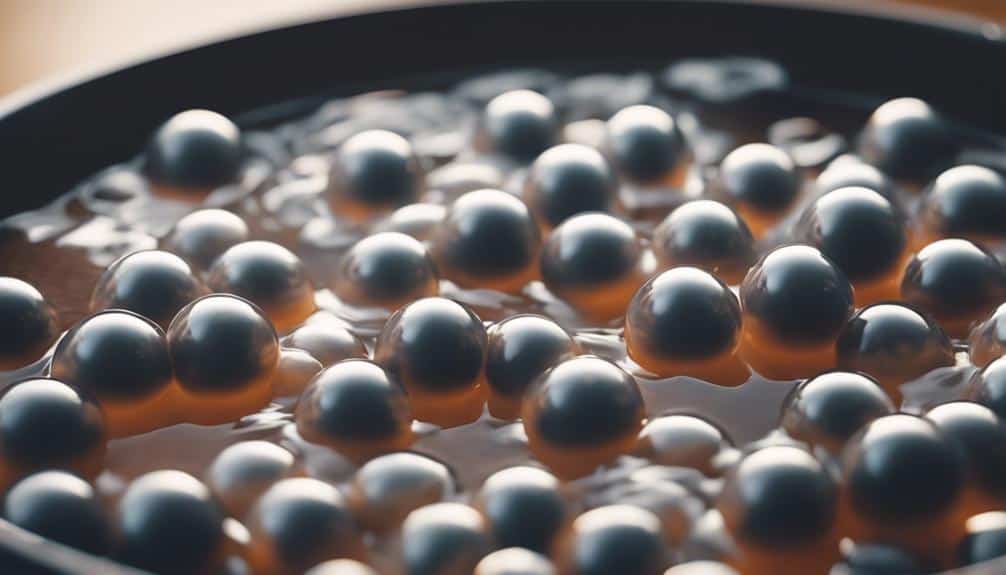
In the process of crafting boba balls, the essential ingredient for achieving their desired chewy texture is tapioca starch. Tapioca starch plays a pivotal role in creating the sticky and chewy consistency that's characteristic of boba balls.
To achieve the perfect chewiness, the gelatinization process of tapioca starch with hot water is necessary. Proper cooking techniques, such as boiling and simmering, further enhance the chewy texture of boba balls. It's essential to maintain a delicate balance of ingredients and cooking time to guarantee the ideal chewiness in the final product.
The simmering process allows the tapioca starch to absorb moisture and develop its chewy texture fully. By following the correct cooking methods and paying attention to detail, one can achieve the desired chewy consistency that makes boba balls a delightful treat.
Conclusion
In summary, the key ingredients for making boba balls, including tapioca starch, dark brown sugar, water, and food coloring, play vital roles in creating the perfect balance of texture and flavor.
By carefully crafting the dough and shaping the boba balls, one can achieve the desired chewy texture that makes this popular ingredient in bubble tea so enjoyable.
Mastering the art of making boba balls requires attention to detail and precision in order to create a delicious end result.

